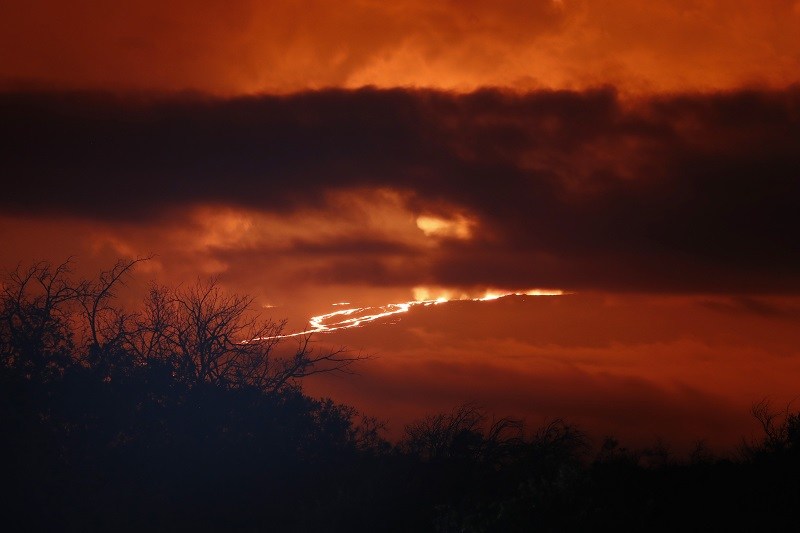
A river of lava flows down from Mauna Loa, Monday, Nov. 28, 2022, near Hilo, Hawaii. Mauna Loa, the world’s largest active volcano erupted Monday for the first time in 38 years.
12:37 JST, November 30, 2022
The eruption of Hawaii’s Mauna Loa, the world’s largest active volcano, has interrupted a key site that monitors greenhouse gas concentrations in the atmosphere, officials said Tuesday.
“The carbon dioxide measurement equipment that maintains the famed Keeling Curve record lost power at 6:30 p.m. Nov. 28 and is not currently recording data,” the University of California at San Diego’s Scripps Institution of Oceanography said in a statement.
The site, selected by the late scientist Charles David Keeling as an ideal spot to measure CO2 due to its relative isolation and vegetation-free landscape, has been recording atmospheric concentrations of the planet-heating gas since the late 1950s.
The Keeling Curve – a chart that shows the steady rise of carbon in the atmosphere in recent decades, as measured at Mauna Loa – is considered a simple yet important piece of scientific evidence that human activities are transforming the Earth’s climate.
“It’s a big eruption, and it’s in a bad place,” Keeling’s son, Scripps geoscientist Ralph Keeling, said in a statement Tuesday about the lava flows at Mauna Loa, located at the heart of Hawaii’s Big Island. He described the outlook for future CO2 readings from the station as “very troubling.”
Earlier, Scripps tweeted that the ongoing eruption “is flowing close to the observatory” and that measurements probably would shut down.
A spokeswoman for the National Oceanic and Atmospheric Administration, which makes complementary CO2 measurements with Scripps Oceanography at Mauna Loa, said in an email Tuesday evening that lava from the eruption crossed an access road to the observatory and took out power lines to the site.
All NOAA staff at the observatory are safe, she said, but the facility is not accessible.
Atmospheric CO2 measurements are maintained at multiple spots around the globe, from the South Pole to Alaska, though the site at Mauna Loa has the best known and most continuous record in the world.
The current outage is not the only time measurements at the site have faced an interruption.
Scripps said Tuesday that there have been “occasional times” in which measurements have not been available because of excessive variability in hourly readings.
There were also “sustained periods without measurements” in 1964, when budget cuts within federal agencies led to suspending operations at Mauna Loa for several months, Scripps said. And a previous eruption at the volcano in 1984 cut power, leaving the observatory without readings from March 26 to April 29 that year, when a generator arrived and operations resumed.
The measurements at Mauna Loa over the years have charted the profound impact of human activities, primarily the burning of fossil fuels. Last summer, the Intergovernmental Panel on Climate Change found that carbon dioxide in the atmosphere has risen to levels not seen in 2 million years.
NOAA says there is widespread confidence that the measurements at Mauna Loa “reflect truth about our global atmosphere” for several reasons. Its high altitude near the summit is an ideal spot to measure air masses “representative of very large areas,” the agency says.
In addition, NOAA says, “all of the measurements are rigorously and very frequently calibrated,” and the ongoing nature of independent measurements at the same site allow for more precision over time.
The eruption at Mauna Loa marks its first in nearly four decades. The U.S. Geological Survey said it began about 11:30 p.m. local time Sunday in Mokuaweoweo, the summit caldera of Mauna Loa.
It was visible from Kona, a popular tourist destination on the island’s west coast, though authorities have said that while its lava flows could threaten some roadways, there is no immediate danger to populated areas.
"News Services" POPULAR ARTICLE
-

American Playwright Jeremy O. Harris Arrested in Japan on Alleged Drug Smuggling
-

Japan’s Nikkei Stock Average as JGB Yields, Yen Rise on Rate-Hike Bets
-

Japan’s Nikkei Stock Average Licks Wounds after Selloff Sparked by BOJ Hike Bets (UPDATE 1)
-

Japan’s Nikkei Stock Average Buoyed by Stable Yen; SoftBank’s Slide Caps Gains (UPDATE 1)
-

Japanese Bond Yields Zoom, Stocks Slide as Rate Hike Looms
JN ACCESS RANKING
-

Keidanren Chairman Yoshinobu Tsutsui Visits Kashiwazaki-Kariwa Nuclear Power Plant; Inspects New Emergency Safety System
-

Imports of Rare Earths from China Facing Delays, May Be Caused by Deterioration of Japan-China Relations
-

Tokyo Economic Security Forum to Hold Inaugural Meeting Amid Tense Global Environment
-

University of Tokyo Professor Discusses Japanese Economic Security in Interview Ahead of Forum
-

Japan Pulls out of Vietnam Nuclear Project, Complicating Hanoi’s Power Plans






















